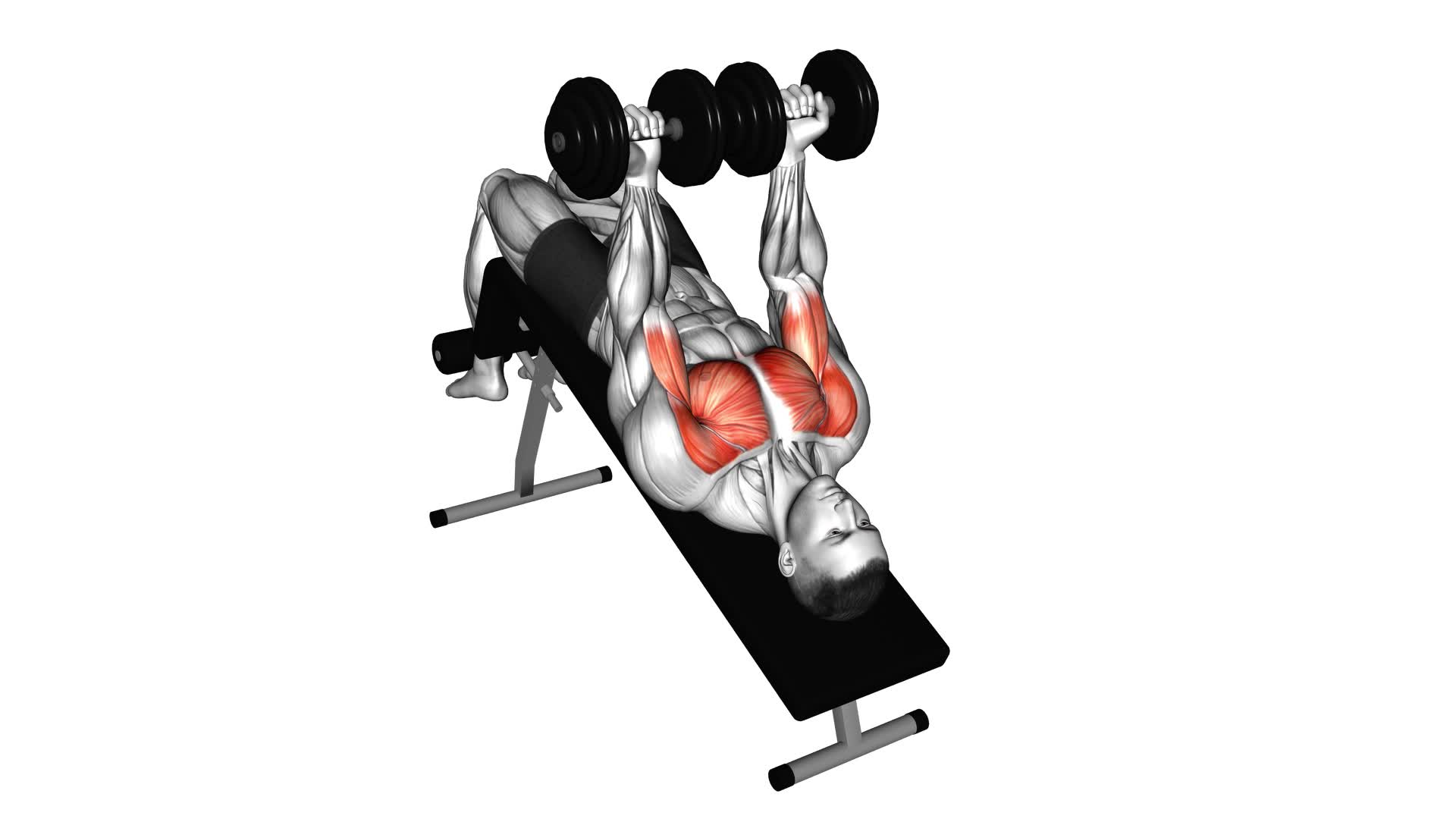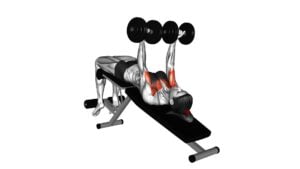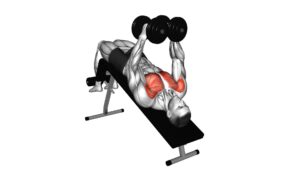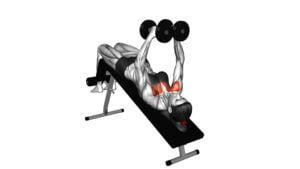Dumbbell Decline Twist Fly – Video Exercise Guide & Tips

Get ready to sculpt and strengthen your upper body with the dumbbell decline twist fly! This exercise targets your chest, shoulders, and core, giving you a full-body burn.
Watch This Exercise Video
In this video exercise guide, you'll learn the proper form and technique, as well as essential equipment and setup.
Maximize your results with our expert tips and discover variations for different fitness levels.
Let's get started and take your workout to the next level!
Key Takeaways
- Targets chest, shoulders, and core
- Enhances shoulder and chest strength
- Engages core muscles
- Promotes stability and coordination
Benefits of the Dumbbell Decline Twist Fly
You will experience enhanced shoulder and chest strength with the Dumbbell Decline Twist Fly. This exercise is highly effective for muscle activation in your shoulders and chest, making it a great addition to your workout routine. The twisting motion engages your core muscles, further challenging your stability and coordination.
When performing the Dumbbell Decline Twist Fly, it's important to focus on your breathing technique. Inhale deeply as you lower the dumbbells towards your chest, and exhale forcefully as you push them back up. This helps to oxygenate your muscles and maintain proper form throughout the exercise.
By incorporating the Dumbbell Decline Twist Fly into your workout routine, you can expect to see improvements in your shoulder and chest strength. This exercise targets the pectoralis major, deltoids, and rotator cuff muscles, helping to build a more defined and sculpted upper body. Additionally, the twisting motion engages your obliques and transverse abdominis, promoting a stronger core.
Proper form and technique for the Dumbbell Decline Twist Fly are crucial to maximize its benefits and prevent injury. Let's now explore the correct way to perform this exercise, ensuring that you get the most out of your workout and stay safe.
Proper Form and Technique for the Exercise
To perform the Dumbbell Decline Twist Fly with proper form and technique, ensure that you maintain a stable and controlled movement throughout the exercise. This exercise primarily targets the chest muscles, specifically the pectoralis major and minor. However, it also engages the muscles of the shoulders and the upper back.
One common mistake to avoid is using excessive weight. It's important to start with a weight that allows you to maintain proper form and complete the movement smoothly. Using too much weight can lead to compromised form and increase the risk of injury.
Another mistake to watch out for is swinging the weights or using momentum to lift them. This can take the focus away from the targeted muscles and decrease the effectiveness of the exercise. Remember to maintain control and move the weights in a slow and controlled manner.
It is also important to keep your back flat against the bench and your core engaged throughout the exercise. This will help stabilize your body and prevent any excessive strain on your lower back.
Essential Equipment and Setup for the Exercise
To properly set up for the Dumbbell Decline Twist Fly exercise, you'll need a bench and a pair of dumbbells. The bench should be positioned on a decline, meaning the head of the bench is lower than the foot. This angle helps target the lower chest muscles and increases the intensity of the exercise. Place the dumbbells on the floor near the bench, within easy reach. Make sure to choose a weight that challenges you but still allows you to maintain proper form throughout the exercise.
Before starting the exercise, it's important to make sure the equipment is set up correctly. Ensure that the bench is stable and secure, as any wobbling or instability can increase the risk of injury. Double-check that the dumbbells are in good condition, with secure grips and no loose parts.
When it comes to exercise modifications, there are a few options to consider. If you don't have access to a decline bench, you can perform the exercise on a flat bench or even on the floor. Additionally, if lifting dumbbells is too challenging, you can modify the exercise by using resistance bands instead. Resistance bands provide a similar level of resistance and can be a great alternative for those with limited access to dumbbells.
Tips to Maximize Your Results With the Dumbbell Decline Twist Fly
To maximize your results with the Dumbbell Decline Twist Fly, focus on engaging your core muscles throughout the exercise. By doing so, you'll not only target your chest, shoulders, and upper back, but also strengthen and stabilize your core. Here are some tips to help you get the most out of this exercise:
- Maintain proper form: Keep your back flat against the bench, your feet firmly planted on the ground, and your shoulders relaxed. This will ensure that you're using the correct muscles and avoiding unnecessary strain.
- Control the movement: Slowly lower the dumbbells out to the sides, feeling a stretch in your chest, and then bring them back up to the starting position. Avoid using momentum or swinging your arms to maintain control and maximize the effectiveness of the exercise.
- Breathe properly: Inhale as you lower the dumbbells and exhale as you bring them back up. This will help you maintain stability and focus on your core engagement.
Common mistakes to avoid include using excessively heavy weights, which can compromise your form, and neglecting to engage your core throughout the exercise. Remember, it's important to listen to your body and adjust the weight accordingly.
If you're looking for alternative exercises that target similar muscle groups, you can try the incline dumbbell fly or the cable crossover. These exercises offer a different range of motion and may provide variation to your workout routine.
Variations and Modifications for Different Fitness Levels
For different fitness levels, you can modify the Dumbbell Decline Twist Fly by adjusting the weight and range of motion to suit your abilities. If you're a beginner or have limited upper body strength, start with lighter weights and focus on mastering the correct form before increasing the weight. As you progress, you can gradually increase the weight to challenge your muscles further.
To modify the range of motion, you can start with a smaller range and gradually increase it as you become more comfortable and stronger. This will help prevent any strain or injury. Remember to always listen to your body and only push yourself within your limits.
When performing the Dumbbell Decline Twist Fly, there are some common mistakes to avoid. One is using momentum instead of controlled movements. Make sure to engage your muscles and perform the exercise in a slow and controlled manner. Another mistake is using heavy weights that are too challenging for your current fitness level. Start with lighter weights and gradually increase as you build strength and stability.
Frequently Asked Questions
How Many Reps and Sets Should I Do for the Dumbbell Decline Twist Fly?
For the dumbbell decline twist fly, it's important to find the optimal weight and maintain proper form. Start with a weight that challenges you but allows you to complete 8-12 reps with good form.
Aim for 3-4 sets, resting for 60-90 seconds between sets. To add variation, you can try different grip positions or use resistance bands instead of dumbbells.
Remember to always listen to your body and modify the exercise if needed.
Can I Perform the Dumbbell Decline Twist Fly Without a Decline Bench?
Yes, you can perform the dumbbell decline twist fly without a decline bench. There are alternative exercises and modifications you can try.
For example, you can do a standing cable twist fly or a decline twist fly on an exercise ball. These exercises will target your chest and shoulders while also engaging your core muscles.
Remember to maintain proper form and start with lighter weights until you feel comfortable and confident in your technique.
Is the Dumbbell Decline Twist Fly Suitable for Beginners?
The dumbbell decline twist fly is a great exercise for beginners looking to improve core strength. It targets your chest, shoulders, and core muscles.
If you don't have a decline bench, you can modify this exercise by using an incline bench or even a stability ball. The twisting motion engages your obliques, helping to strengthen your side muscles.
Incorporating this exercise into your routine can lead to improved stability and overall core strength.
Can I Incorporate the Dumbbell Decline Twist Fly Into a Full-Body Workout Routine?
Yes, you can definitely incorporate the dumbbell decline twist fly into a full-body workout routine.
This exercise is great for incorporating in strength training and provides several benefits for your core workout.
By engaging your chest, shoulders, and core muscles, it helps to improve upper body strength and stability.
Adding this exercise to your routine can help you achieve a balanced and effective full-body workout.
Are There Any Potential Risks or Injuries Associated With the Dumbbell Decline Twist Fly?
When performing the dumbbell decline twist fly, there are potential risks and injuries to be aware of. It's important to use proper form and technique to avoid strain or muscle imbalances.
The twisting motion can put stress on the spine, so it's crucial to engage your core and maintain a stable position. Additionally, using too much weight or performing the exercise too quickly can increase the risk of injury.
Always consult with a professional before attempting new exercises.
Conclusion
The dumbbell decline twist fly is a beneficial exercise that targets the chest and shoulders while also engaging the core muscles. By maintaining proper form and technique, using the essential equipment and setup, and following the tips provided, you can maximize your results with this exercise.
Additionally, there are variations and modifications available for different fitness levels. Incorporate the dumbbell decline twist fly into your workout routine to enhance your upper body strength and stability.

Author
Years ago, the spark of my life’s passion ignited in my mind the moment I stepped into the local gym for the first time. The inaugural bead of perspiration, the initial endeavor, the very first surge of endorphins, and a sense of pride that washed over me post-workout marked the beginning of my deep-seated interest in strength sports, fitness, and sports nutrition. This very curiosity blossomed rapidly into a profound fascination, propelling me to earn a Master’s degree in Physical Education from the Academy of Physical Education in Krakow, followed by a Sports Manager diploma from the Jagiellonian University. My journey of growth led me to gain more specialized qualifications, such as being a certified personal trainer with a focus on sports dietetics, a lifeguard, and an instructor for wellness and corrective gymnastics. Theoretical knowledge paired seamlessly with practical experience, reinforcing my belief that the transformation of individuals under my guidance was also a reflection of my personal growth. This belief holds true even today. Each day, I strive to push the boundaries and explore new realms. These realms gently elevate me to greater heights. The unique combination of passion for my field and the continuous quest for growth fuels my drive to break new ground.







